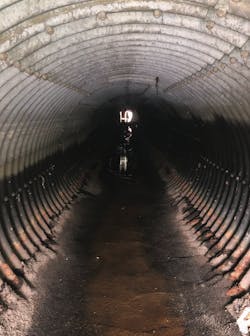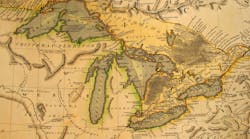Stormwater pipes and culverts (pipes) serve a valuable function in a community’s subsurface infrastructure. Not only are they an essential component to ensure excess runoff is reliably drained from impervious surfaces such as paved streets, parking lots, footpaths and sidewalks, but they also play a crucial role in the complete storm water management system. By allowing subsurface conveyance of runoff, storm water pipes and culverts eliminate the safety hazards and damage standing and running water can cause by remaining above grade.
In addition to directing stormwater flow, stormwater pipes help cities and local governments control erosion. The proper management and control of erosion is critical to prevent potentially catastrophic damage to commercial and residential structures, roadways, and other infrastructure, safeguarding the families who live, work and play in communities. To many, seeing soil deposited on a road is cause for concern, however for those in the stormwater industry it is much more concerning when soil is generated from erosion around pipes, channels, embankments and other stormwater control features. To prevent dangerous erosion that can lead to a devastating loss of the very infrastructure relied upon to control stormwater, it is critical to properly maintain stormwater piping systems to ensure proper flow and structural integrity.
For stormwater drainage applications, corrugated metal pipe (CMP) remains a material of choice for Departments of Transportation (DOT), utilities and municipalities due to its inexpensive cost, anticipated service life and ease of placement in the field. While these are important benefits, CMP can pose a few challenges in certain environments – potential for corrosion, offset joints and difficult sediment removal.
Fortunately, there are pipe lining methods available today that restore structural integrity and eliminate the causes of soil erosion and subsidence for greater longevity and performance, maximizing cities’ pipe investment. Each pipe rehabilitation method offers distinct advantages and disadvantages based upon each particular project.
Storm Water Rehabilitation Options
Invert-only pipe repairs utilizing spray or trowel-applied mortars are a temporary fix that may present the appearance of a structurally restored pipe. However, this is not the case unless the existing CMP is structurally tied into the newly placed invert lining, which adds considerable cost to the project. Failure to perform this critical step can cause severe defects, including ovality, joint separation and continued structural degradation of the pipe or culvert. It is best to monolithically line the host pipe, eliminating the potential for defects and soil loss outside the pipe.
While sliplining protects a pipe’s hydraulic capacity, it significantly reduces a pipe’s overall dimension. When a large amount of diameter is lost, a pipe can become difficult to inspect and maintain. Additionally, large debris may become trapped within the pipe, increasing the possibility for build-up and flow interruption, which ultimately creates a hydraulic restriction. Sliplining often requires expensive access and laydown areas to fuse and pull the new pipe within the host pipe, which must be restored at the project’s completion.
Cured-in-place pipe (CIPP) offers a tight-fitting alternative with a relatively thin liner cross section, however it is not ideal for CMP rehabilitation projects as it is cost-prohibitive for large pipes and is unable to fully adhere to corrugated sections, leading to subsidence in the remaining annular space. CIPP may also restrict access to CMP culverts located on embankments or off-road. Plastic-based liners are also not suitable for this application as the material is susceptible to natural and man-made fires, which have increased in rural and urban settings, resulting from climate change and homeless populations increasingly using stormwater pipes for shelter.
Although traditional and hybrid cement mortar products are often used for pipe rehabilitation, they lack appropriate abrasion resistance to prevent degradation from recurring and are prone to cracking.
Given the complexity of CMP repairs and the limitations of current repair options, geopolymer mortar pipe rehabilitation is a growing best practice for restoring stormwater pipes more than 36 inches in diameter. Geopolymer mortars excel where traditional cements, expensive composite systems (cement + epoxy) and other rehab methods fall short. Unlike traditional cement mortars which bind to aggregates, geopolymers use an alkaline liquid, such as water, and an alumino-silicate precursor to create a catalyst to trigger a polycondensation chemical reaction that forms a covalently bonded amorphous network. This reaction yields high early strength as well as long-term physical benefits.
Geopolymers’ spray application is well-suited for CMP repair work. A spin-cast or hand-sprayed geopolymer mortar liner system constructs a new pipe using the host pipe as a base, removing annular space while plugging holes to yield a solid enclosed pipe with full structural value – eliminating the need for traditional excavation and replacement. This provides the flexibility to maintain corrugations for a slower flow that’s beneficial to wildlife or to fill corrugations for a smooth final pipe which enhances conveyance and maintenance.
Geopolymer pipe rehabilitation is minimally disruptive to the surrounding community and can be completed quickly with a minimal footprint. It maintains cross-sections, enabling it to fully replace the host pipe structurally, while preserving or increasing hydraulic capacity. This material also offers superior abrasion, chemical and heat resistance that withstands abrasive flows, de-icing salts, saltwater and man-made spills and fires, providing decades of structural integrity and performance.
Culvert Before Repairs
The experience of a Department of Transportation (DOT) in New England illustrates the advantages of employing geopolymer mortar lining for pipe rehabilitation. A 210 linear foot 90-inch diameter CMP storm culvert installed beneath a major roadway decades ago showed severe deterioration marked by several missing pipe sections. The roadway above it had begun to settle, increasing the potential for collapse. Over the course of one week, the culvert was thoroughly cleaned, and extensive repairs were made. Quadex GeoKrete geopolymer mortar and reinforcing mesh were used to repair the missing pieces of pipe. To complete the rehabilitation, a two-inch thickness of GeoKrete was precision spin-cast to create a new, stronger, abrasion-resistant, longer-lasting pipe that protected the roadway’s integrity; excavation wasn’t necessary. Ensuring the integrity of storm water pipes and minimizing erosion effects no longer requires lengthy and disruptive pipe replacement. Geopolymer pipe lining offers unobtrusive installation, the flexibility of creating a smooth or corrugated finish as well as superior strength and longevity. It is an option to repair storm water management systems for optimal conveyance and prevention of soil erosion and subsidence.






